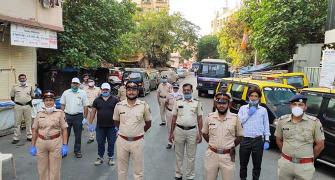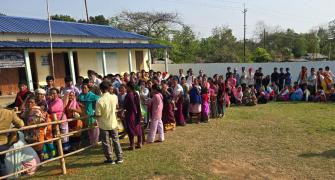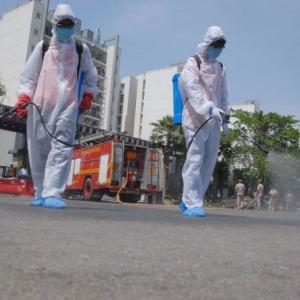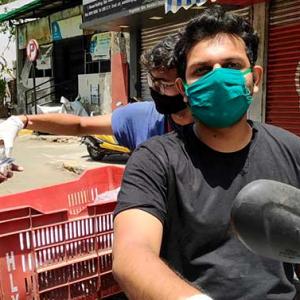As we get used to a long haul of isolation to curb the spread of COVID-19, the police's new avatar in many places is a far cry from that of the high-handed enforcer of law and order.
Ritwik Sharma reports.

Since India turned into a veritable prison on March 24, images of lathi-wielding policemen have gradually given way to those of a friendly and even entertaining force.
Instances of the police beating up people out to buy groceries, making a bunch of migrant workers hop like frogs on a highway and also not sparing some essential service providers initially induced fear and sparked outrage among many.
Yet, as all of us get used to a long haul of self-quarantine and isolation to curb the spread of the COVID-19 contagion, the police's new avatar in many places is a far cry from that of the high-handed enforcer of law and order.
The coronavirus crisis has presented police across Indian states an opportunity to enhance their presence and impact on social media.
On March 22, as citizens responded to the prime minister's call of Janata Curfew, the Punjab government decided on a state-wide lockdown till the month-end.
A couple of days earlier, digital marketing firm DesignBoxed volunteered to work with the Punjab police.
It wanted the police to be seen in a humane light.
Particularly since they had to go beyond implementing curfew to deliver essential goods to people, being the only department with visible presence on the street.
Then followed creative videos that have animation of policemen performing bhangra, memes and posts as well as live sessions with officers explaining dos and don'ts.
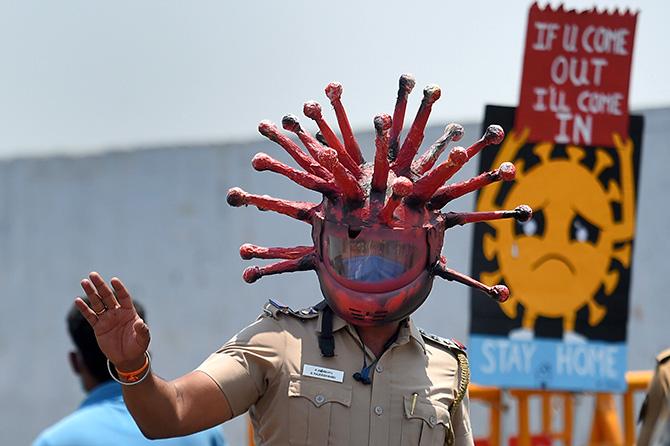
In Punjab, which has one of the best police-to-people ratios among Indian states, the men in khaki are not expected to be cordial and are seen as a power centre, admits Naresh Arora, director, DesignBoxed.
To spread awareness on coronavirus, the Punjab police also opened an account on video-sharing app TikTok (the most downloaded app in India during the lockdown).
In 10 days, the Punjab police's videos clocked more than 50 million views.
"We didn't want to be preachy, and produced district-wise messaging in a creative manner. Because we are virtually in a jail, the police are also telling people how they can spend time at home and learn new things," says Arora, who also handles digital campaigns for political leaders.
Surendra Lamba, executive assistant-cum-staff officer to Punjab's director general of police, says the campaigns have helped build a better public perception.
"Based on the engagement on Facebook, Twitter, Instagram, TikTok and Sharechat, we can say that many people are responding positively to the campaigns."
TikTok has become an effective medium for police in other states, too, including Karnataka, Chhattisgarh and Kerala.
From the police in Kolkata delivering 'corona' renditions of popular numbers in public and traffic cops in Bengaluru wearing virus-shaped helmets to dissuade violators to a garba performance by policewomen in Gujarat, innovative ways to stress the importance of physical distancing and staying at home have caught on.

In Assam, Additional Director General of Police Harmeet Singh says the state police is firm in enforcing the lockdown without exceptions.
That said, he adds, it realises there are sections that are underprivileged and also animals that are vulnerable.
"So we are providing relief material and helping NGOs that are distributing aid all over the state."
The Assam police is also running helplines and coordinating with local authorities to deliver essential goods.
Besides sensitising people through social media, the police have counselled more than 150 people and arrested 31 so far in order to curb fake news -- and, it alerts Facebook and Twitter when it spots misinformation.
A majority of the COVID-19 positive cases reported in Assam were linked to the Tablighi Jamaat incident in Delhi, so the police have run a campaign to ensure peace.
These efforts indicate that a people-friendly image is a work in progress for the police.
However, even during an unprecedented crisis that has compelled everyone to set aside the usual blame game and work towards solution, questions over the police's role remain.
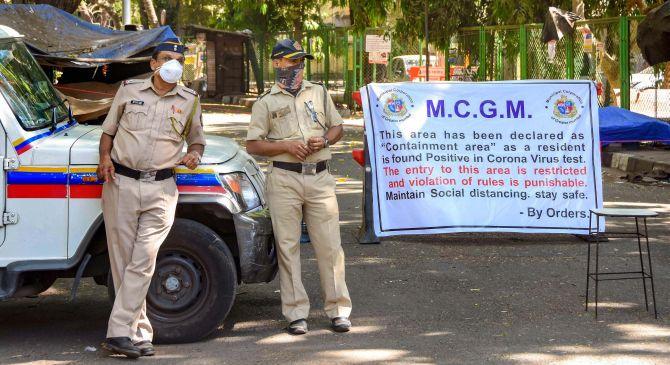
The Delhi police has been battling accusations of bias and violent crackdowns during the anti-Citizenship (Amendment) Act movement and subsequent riots.
The Delhi Minorities Commission issued notices to the police seeking action over 'random arrests' of youth in connection with the riots in north east Delhi.
A criminal lawyer, who did not want to be named, says the urgency of arrests during the lockdown is baffling as everyone is stationed at home.
More so, she adds, when a couple of high courts have either granted bail to undertrials or considered offering parole to prisoners to decongest jails in the wake of the outbreak.
"The thrust of the investigations in Delhi has been that those who participated in the anti-CAA protests are the ones behind the riots," she alleges.
The Delhi police did not respond to interview requests for this article.

The matter of reforms is often raked up when the police department is suspected of partisan behaviour or exercising brutal authority.
Court directions, commissions and experts have repeatedly pointed to gnawing problems such as political interference and lack of functional autonomy or accountability.
The Police Act, 1861 -- on which the police functions are based -- is also cited as a colonial-era law that has long lost its relevance, legislated as it was in the wake of the Indian Rebellion of 1857, also known as the Sepoy Mutiny.
The police tend to reflect the ethos and values of the ruling party, says Prakash Singh, former chief of the Border Security Force and chairman of the advocacy group Indian Police Foundation.

At the same time, Singh feels there is a need for an element of coercion to make people fall in line, especially for a challenge like COVID-19 for which there is no standard operating procedure.
The Indian Police Foundation has called upon police chiefs to formulate pandemic preparedness plans.
While there is no justification for excessive use of force, Singh says that on the whole the police have done a good job of disciplining people and implementing the lockdown.
The police are also working on the frontlines, distributing relief material and medicines, and exposing themselves to health risks with many lacking even protective gear.
"The government has given insurance cover to health workers, but not to the police. Why?" asks Singh.
Ajay Raj Sharma, former commissioner of police in Delhi, says the constant challenge is to be strict and humane at the same time.
After eight-10 hours of duty, there should be a switch, and police personnel should be able to rest and meet their families, he says.
"It is necessary to keep them sane when they are on duty."



